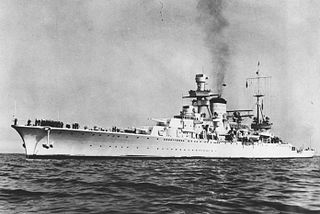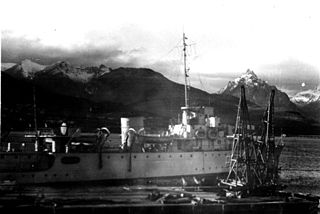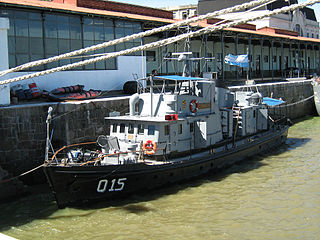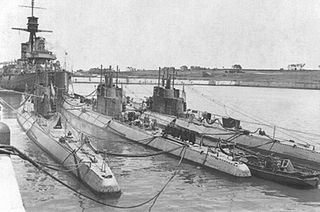
The two Veinticinco de Mayo-class heavy cruisers served in the Argentine Navy through World War II. They were the only post-Washington Naval Treaty heavy cruisers built for a South American navy. Both ships of the class were built in Italy by the OTO company, and commissioned into the Argentine Navy in 1931.

ARA Veinticinco de Mayo was a cruiser which served in the Argentine Navy. The English translation of the name is May 25, which is the date of Argentina's May Revolution in 1810.

The Buenos Aires-class destroyers were a group of destroyers built for the Argentine Navy in Britain in the 1930s.

ARA Bahía San Blas is an amphibious cargo ship of the Argentine Navy, capable of unloading landing craft, troops, vehicles and cargo. She is the first Argentine Navy ship to bear the name of San Blas Bay of in the south of Buenos Aires Province.

ARA King is a World War II-era Argentine Navy warship, originally classified as minelayer and later as patrol ship. The vessel is named after Juan King, an Argentine naval officer that served in the Cisplatine War. It is the third Argentine naval ship with this name.

ARA Azopardo is a World War II era Argentine Navy warship, originally classified as patrol boat and later as antisubmarine frigate. The vessel is named after Juan Bautista Azopardo, an Argentine naval officer that served in both the Argentine War of Independence and in the Cisplatine War. It is the third Argentine naval ship with this name.

ARA Piedra Buena is a World War II era Argentine Navy warship, originally classified as patrol boat and later as antisubmarine frigate. The vessel is named after Luis Piedrabuena, an Argentine mariner that explored and guarded Argentine sovereignty in Patagonia. It is the third Argentine naval ship with this name.

ARA Cormorán (Q-15) is a hydrographic survey boat of the Argentine Navy, built in the Río Santiago Shipyard and based in Buenos Aires. The vessel is named after the cormorant, a seabird that inhabits Argentina’s littoral, and is the fourth Argentine naval ship with this name.
ARA Petrel was a hydrographic survey boat of the Argentine Navy, built in the Cadenazzi Shipyard and based in Buenos Aires. The vessel is named after the petrel, a seabird that inhabits Argentina's littoral, and is the third Argentine naval ship with this name.

ARA Zurubí (P-55) is a patrol boat of the Argentine Navy, built in the Río Santiago Shipyard in 1938 and based in Ushuaia. The vessel is named after the Surubí, a catfish that inhabits Argentina’s Mesopotamia, and is the first Argentine naval ship with this name.

The Murature-class patrol ships are a class of World War II era Argentine Navy warships, originally classified as minelayers and later reclassified as patrol ships. The class is named after José Luis Murature, Foreign Minister of Argentina from 1916 to 1918.

The Santa Fe-class submarines, also known as the Tarantinos after the city in which they were built, were a class of three pre-World War II submarines, designed and built in Italy in 1928-1933, as part of an Argentine expansion plan for its navy. They were in service with the Argentine Navy from the early 1930s to the late 1950s. The class was named after Argentine provinces starting with “S”, as traditional in the Argentine Navy.

ARA Cabo de Hornos (B-5) was a cargo ship in service with the Argentine Navy since 1979, capable of transporting bulk cargo, live cattle, and containers. She was the second ship in the Argentine Navy to bear the name of the Cape Horn (Chile) located to the south of Tierra del Fuego.

ARA Canal Beagle (B-3) is a cargo ship in service with the Argentine Navy since 1978, capable of transporting bulk cargo, live cattle, and containers. She is the second ship in the Argentine Navy to bear the name of the Beagle Channel in the south of Tierra del Fuego.

The Costa Sur-class cargo ship is a class of three cargo ships designed and built in Argentina in 1975–1979 for servicing the Patagonic coast routes; capable of transporting bulk cargo, live cattle, and containers. The ships have been in service with the Argentine Navy since 1978. The class is named after the southern coastal area of Argentina which was designed to service.
ARA Ingeniero Julio Krause (B-13) was an oil tanker ship in service with the Argentine Navy from 1993 to 2015, and with YPF from to 1981 to 1993. She was the first ship in the Argentine Navy to bear the name of Argentine engineer Julio Krause, who discovered oil in Comodoro Rivadavia in 1907.
ARA Santa Cruz was an auxiliary ship of the Argentine Navy, built in the Fairfield Shipbuilding & Engineering Shipyard, Govan, Scotland, in 1921. She was transferred to the YPF tanker fleet after arrival in Argentina, and remained in YPF service until decommissioned and scrapped in 1948. The vessel was named after the Argentine province of Santa Cruz, and is the ninth Argentine naval ship with this name.
ARA Luisito (Q-51) is a training ship of the Argentine Navy, in service since 1985 and based in Mar del Plata; where she is used to train students from Argentina’s National Fishing School. The vessel is the first Argentine naval ship with this name.













